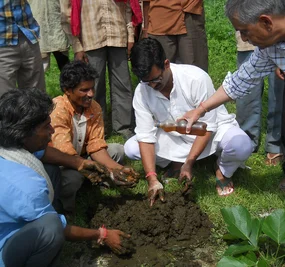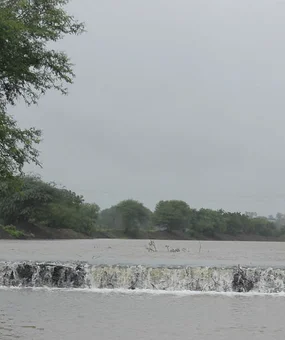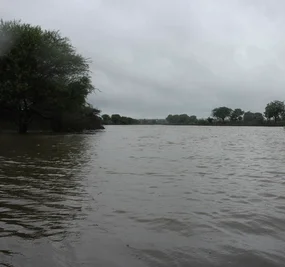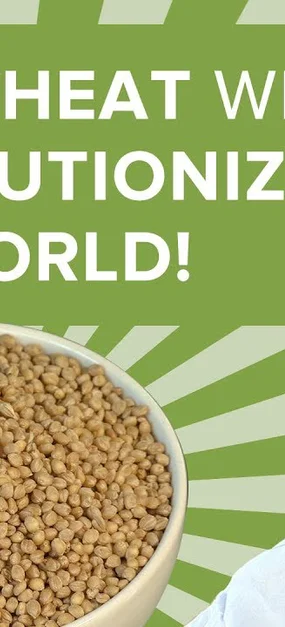“To forget how to tend the soil is to forget ourselves.”
– Mahatma Gandhi
Notorious for getting caught in our shoes, socks, coming all the way home and hiding under our fingernails. There would hardly be anyone who has not had a sweet-and-sour relation with soil.
Known popularly as dirt – the silly old dirt to everyone – soil is seldom appreciated for the vital role it plays in our lives and in the environment. A medium that we have to plow and fertilize in order to grow our food in, soil provides services critical for life. First and foremost, it is a growing medium and the basis of our nation’s agrarian economy providing us with food, fodder, fiber, and fuel. It is home to billions of organisms and supplies most of the antibiotics used to fight diseases. It is the very foundation for our cities and towns and life on earth.
Even then, it is rendered lifeless. The World Soil Day, celebrated annually on December 5th, brings an exclusive opportunity to relook at the wonders of soil. Let’s understand and accord it the value that it deserves, not just for the marked day, but everyday. In keeping with the theme for 2019, ‘Stop soil erosion, save the future’, The Art of Living has adopted various methods over the past many years to save soil.
But first, how is soil formed?
Soil is a mixture of rock particles, minerals, decayed remains of plants and animals, air and water. It is formed as rock is broken down by weathering, water and wind erosion, changes in temperature and pressure, the force of gravity and living organisms. Plants and animals mix humus with other material in this rock residue and burrowing animals help aerate the soil.
It takes between 200 to a 1,000 years to produce 2.5-3 cm of soil. The thin layer of topsoil that covers the planet’s land surface is about six inches [15cm] deep. It took eons to form as new soil formation exceeded the natural rate of erosion.
Some interesting soil trivia:
1) There are more living organisms in a tablespoon of soil than there are people on earth
2) The more fungi in the soil, the more carbon the soil will store
3) It can store up to 9,200 tonnes of water per acre, greatly reducing flood risk
4) About 10% of the world’s carbon dioxide emissions are stored in soil
5) Archaeologists have determined that the demise of many sophisticated civilizations such as the Mayans of Central America and the Harappan of India, resulted directly from the mismanagement of their soils
6) Almost all of the antibiotics we take to help us fight infections are obtained from soil microorganisms
7) Agriculture is the only essential industry on earth
8) The best china dishes are made from soil
9) About 70% of the weight of a textbook or glossy paged magazine consists soil
(Source: Soil Science Society of America & related sites.)
When the alarm bells ring loud & clear
Why has soil suddenly become the focus of not just farmers, agriculturists, soil scientists, hydrologists and environmentalists but ordinary people like you and me?
Sometime in the last century, as human and livestock populations exploded, soil started eroding at an unprecedented rate. It began to exceed new soil formation almost everywhere in the world.
We are losing our topsoil at an alarming rate and desertification of agricultural land has emerged as a new challenge for the farming community and soil scientists alike.
In the next 40 years, earth will be home to 2 billion more people – another China plus India, so food production will have to shoot up by at least 40% while only 11% of land surface is available for growing food.
Soil erosion usually occurs so slowly that it has taken us decades to even become aware of the damage. The loss of 1mm of soil is so miniscule that it goes undetected. But over a 25-year period the loss is an irreparable 25mm, which would take about 500 years to replace by natural processes.
The list is endless.
What is soil erosion after all?
The wearing down of the topmost layer of the earth is soil erosion. This is caused by deforestation, wind, water, overgrazing, urbanization and reduction in vegetation cover.
Soil conservation done right
But all is not lost. At The Art of Living, the volunteers and experts have been noticing the degradation and destruction of this precious resource. In an attempt to help the toplayer survive, many initiatives, projects and solutions have been taken, and are still ongoing, to help the soil vis-a-vis the agricultural community. One of the most important ways to accelerate the drop in erosion rate is through natural farming. Creation of artificial recharge structures like boulder checks and gabion structure across streams control and reduce soil loss from farmlands and from streams.
India is an agrarian society. Our ancient people were not only agricultural scientists but naturalists as well. They knew the value of the fragile top layer of soil and had devised various practical yet scientific methods to conserve it. It is towards these time-tested solutions that we looked to as we trained the farmers.
We encouraged the farmers, who were using chemical fertilizers, to return to natural farming.
Natural farming includes:
– preparation of jeevamrutha (made with the dung and urine of native Indian cows, jaggery, gram flour and water).
– mulching (the process of mixing the plant remains after harvest and other dead and alive plants with the soil,mostly to retain the soil moisture).
– preparing bio enzymes (natural growth promoter and pest control liquid), etc. which eventually increases the organic matter in the soil, over a period of time.
The benefits of natural farming
- Improves soil fertility
- Improves organic matter in the soil and with every percent increase in organic matter, the water absorption capacity of the soil increases by 187,000 liters per hectare
- Moisture in the soil is retained for a longer period of time
- Soil becomes friendly for earthworms and other microorganisms
- The physical, chemical, and biological properties of soil are enhanced
Natural farming promotes agroforestry which has the following advantages:
- Trees keep the soil intact and control soil erosion naturally
- The green cover reduces exposure of soil to sunlight which saves essential microorganisms vital for maintaining optimum soil health
- Selective species can also enhance and balance the ratio of nitrogen, phosphorus and potassium in the soil. These three nutrients compose complete fertilizers essential to plant growth and are very active during photosynthesis
- Compliments the benefits of natural farming, drastically improving soil health
The impact of natural farming
Here are a few videos that will give you an insight into the work, the strategy and its impact in the agriculture sector.
Amrut Gample – 1 tonne wheat produced from 0.5 acre
Latur – Small farmers making big profits
Natural farming is environment-friendly and sustainable. The cost of production is low and it is sustainable production. Chemical farming requires high monetary investment for purchase of key inputs like hybrid seeds, fertilizers and plant protection chemicals from the market. In natural farming all inputs are used from their own farm itself.














